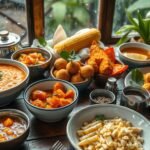Exploring the art of using leaves in cooking provides a glimpse into history worth exploring. Nevertheless, the unique combination of culturally diverse cuisine and a sustainable method for cooking and serving food remains widely popular. It’s no wonder that different forms of wrapping food in leaves can be found in most if not all, countries of the world.
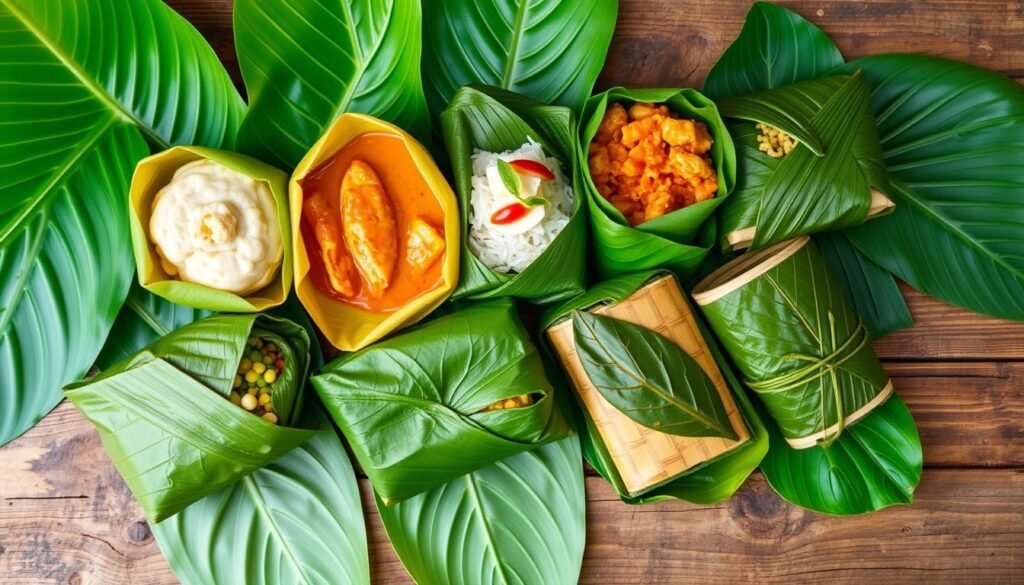
Exploring the Global Tradition of Leaf-Wrapped Cuisine
Banana leaves are used in many traditional dishes across Latin countries. In Asia, bamboo leaves are attached to rice dumplings and other foods. The distinctive features of wrapping food in leaves are strong flavors and smells that leave a lasting impression. Such cooking techniques surely demonstrate the versatility of food traditions across different parts of the world.
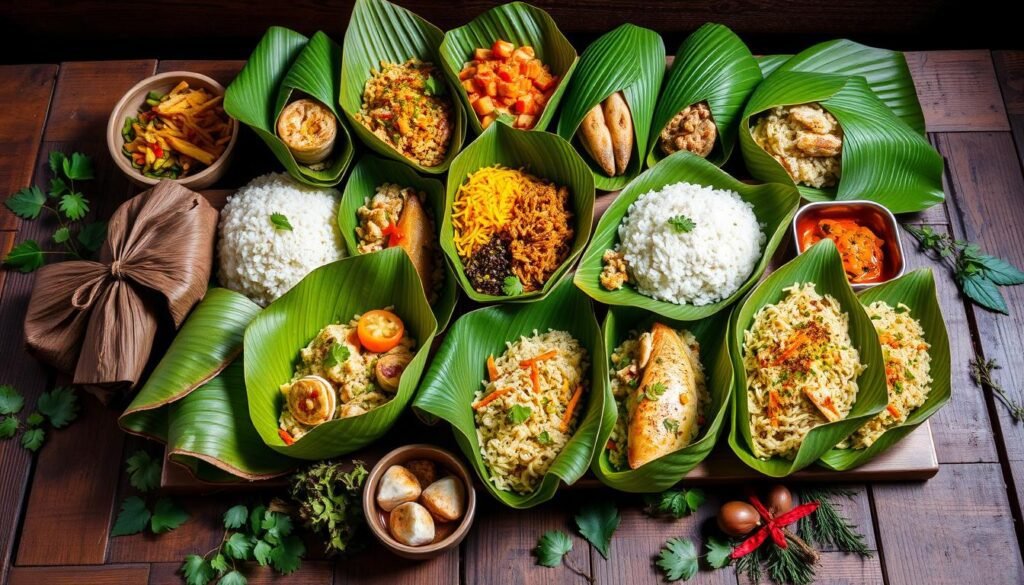
Many love leaf-wrapped foods – Mexican Cochinita Pibil, Chinese Zongzi, and Middle Eastern Dolmas, to name just a few. Such dishes will pique one’s curiosity with the potential they possess regarding new and exciting ways of preparing food.
Explore 7 Leaf-Wrapped Foods From Different Countries Across The Map
Let us take you on a journey around the world with our food. We will show you 7 different leaf-wrapped foods from various parts of the world. Speaking of food, every culture has something to participate in, like zongzi from China or tamales from Latin America.
Let’s explore the leaf wrapping customs with some interesting examples:
- Zongzi: These dumplings made of sticky rice and wrapped in bamboo leaves are a traditional Chinese food with a long and interesting background.
- Tamales: Bananas or corn husks aren’t just for decoration; in Latin America their importance when preparing certain regional dishes is unquestionable.
- Dolmas: These cylindrical grape vine leaves are put around rice with additional seasonings originating from Middle Eastern countries.
- Smoked Fish Parcels: A step above – these wraps come from various places where there are oceans, and encase tasty special smoked fish.
- Banana Leaf Dishes: Southeast Asia loved to pierce a banana leaf, unlike the British who still prefer a piece of paper, for many traditional dishes.
- Thai Miang Kham: This rolled-up leaf is a Thai treat with distinctive flavors of sweetness, sourness, and spiciness altogether.
- Cochinita Pibil: This authentic Mexican pork dish is banana leaves wrapped around succulent chunks of slow-cooked pork.
Join us in the exploration of food traditions that are rich in diversity and well-researched ancient dishes that have long been in existence in the culinary world. They exclaim how strong the bond of food can be for unclenching cultures around the globe.
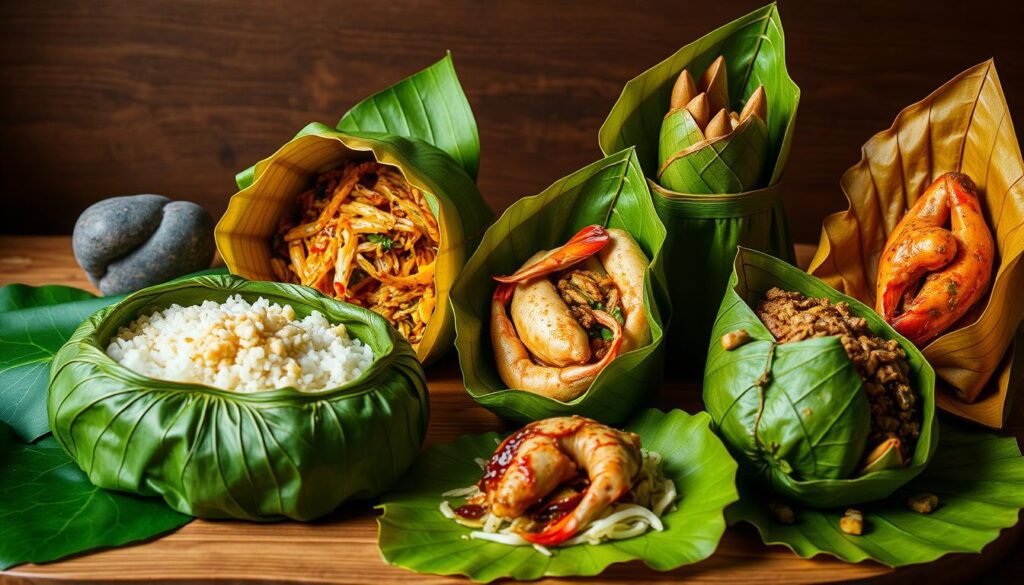
Thai Miang Kham: A Flavorful Leaf-Wrapped Delight
Step into the wonderful world of Thai kitchen and try out the famous Thai Miang Kham. This particular dish can be considered a genuine representation of the culinary practices of Thailand. It illustrates the overall aspects of the local cuisine and particular food culture of this country.
Secretly hidden inside the aromatic betel leaves, Thai Miang Kham is a palette of different tastes — sweetness, sourness, saltiness, as well as hot and spicy notes. This snack is the result of what the Thai cooks refer to as their ‘magic’, using fresh and locally sourced produce to create a truly unique dish.
The preparation of Thai Miang Kham is interesting in itself. Other ingredients are placed into the first cover and then wrapped around with leaves. This technique preserves the aroma and serves a stunning plate. It is a feast for tongues and also provides a view of culinary practices in different countries.
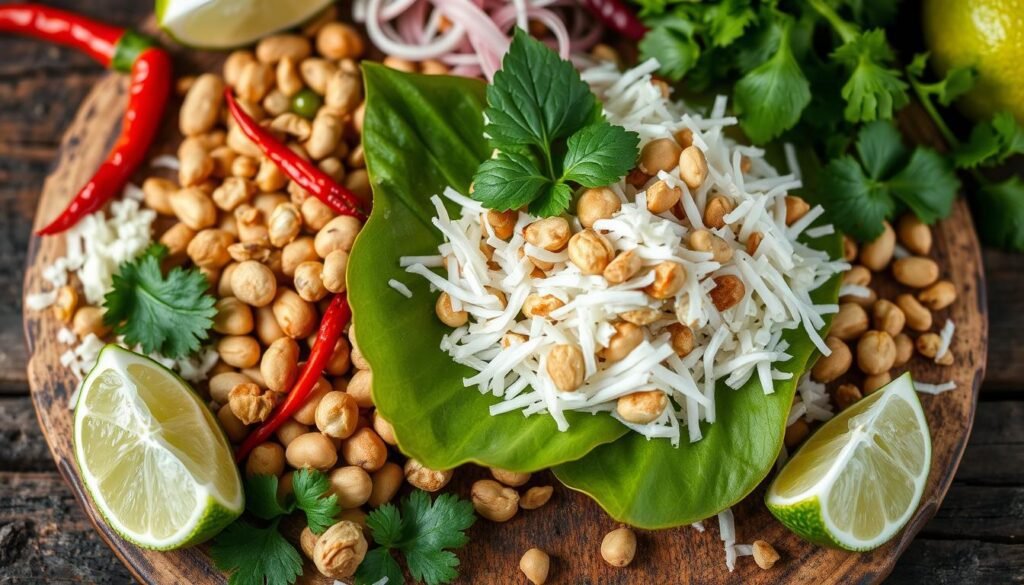
Thai Miang Kham is considered to be a crown jewel of cuisines that require minute leaf wrapping techniques. It depicts the beauty of the fusion of food cultures. We celebrate how in the process of eating this dish, we embrace everything in nature that goes into making this world spicy and colorful.
Mexican Cochinita Pibil: Succulent Pork Wrapped in Banana Leaves
Immerse yourself into the delicious Mexican history with the Mexican cochinita pibil. The dish consists of marinated pork shoulder that is prepared with a combination of achiote paste, citrus, spice, and salt, then banana leaves are used in wrapping and cooked for a long time.
The outcome is an appetizing taste and texture combination. It honors the multicultural food of Mexico.
Cochinita pibil, sometimes simply called pibil, is a Mexican dish from the Yucatan, known for its unique preparation and the fragrance of its spices. Unlike most practitioners of this cuisine, Mexican chefs stand out for their mastery of spice-inducing oils traditionally used to luxuriate in the depth of flavor as an aromatic sauce.
Bananas or palm leaves are known to add flavor, particularly when wrapped around the pork meat to give it a deep and rich taste; it gives this dish an excellent and unique touch. This meal reflects Mexico’s rich history combining innovation and cultural influences.
Considering the cross-cultural aspect of wrapped food across the globe, it can be said that Mexican cochinita pibil stands out. It utilizes the resources of laid down practices and expounds them. It is a delightful anticipation to experience a culture that has been around for ages, Mexican cuisine.
You may appreciate cochinita pibil as a food filler or taco; it will surely not disappoint. It is also a smaller part of a larger Mexican elaborate spread. It wows the crowd with its flavor complexity.
This example speaks for itself on how history can sustain a dish. It evolves. And shaped that evolution into something extraordinary.
Tamales: The Latin American Leaf-Wrapped Food Revisited
Used for centuries, tamales are popular and an integral part of Latin America’s gorgeous safari culinary world. It endorses exquisite tastes and approaches to international chefs. The typical dish is a symbol of the cultural and culinary mentality of the region.
At the center of the tamale is a dough-based preparation of corn masa. It is prepared with restraint and is hidden within corn husks or banana leaves. The fillings can range from savory or juicy meat and veggies to sweet fruits and other fillings.
The history of making tamales is quite ancient. It belongs to the wisdom of the indigenous peoples of Mexico, Guatemala, and Venezuela. This practice helps to preserve the cultural values and also indicates how local food cultures evolve.
In countries across the globe, tamales are a favorite delicacy, irrespective of whether they are steamed, boiled, or baked. They are made out of leaves which not only add beauty but also trap moisture and smell. While moving around the globe looking at leaf-wrapped dishes, tamales are representative of the beautiful culinary diversity and food culture of Latin America.
Zongzi: The Chinese Sticky Rice Dumpling Tradition
In China, zongzi is totally different from tamale. This is also a Chinese cuisine but a sticky rice dumpling which is wrapped in first layer of bamboo and lotus leaves. These dumplings are stuffed with mouth-watering constituents and feature prominently during the Dragon Boat Festival.
Zongzi has existed for thousands of years already. Making them is the craftsmanship of many collective generations. Cooked rice is spread forming layers of stuffing made out of pork and sweet red bean paste, afterwards, it is wrapped in leaves.
Chinese rice dumplings Zongzi are very interesting, they look so beautiful and taste so good. The flavors of the rice, fillings, and leaves, blend harmoniously. They demonstrate the diversity and richness of Chinese cuisine.
The experience of exploring Zongzi is simply amazing. It is an experience to witness how ancient styles of cooking persist in modern recipes.
Dolmas: The Middle Eastern Grape Leaf Rolls
Dolmas, the Middle Eastern grape leaf rolls, are a highlight in global food traditions. They are filled with rice, herbs, and spices. These are wrapped in tender grape leaves, offering a perfect mix of flavors and textures.
Dolmas are also known as stuffed grape leaves in Arabic and are popular in Middle Eastern countries. They are a good representation of the region’s contribution to food craftsmanship. The use of leaves to encase the filling is a characteristic feature of Middle Eastern food.
Dolmas are very tasty delicacies but they also have tremendous ethnicity associated with them. They are sometimes regarded as starters or side dishes or indeed meals on their own. All this shows the significance of food in Middle Eastern culture and society.
Conclusion: Embracing the Diversity of Leaf-Wrapped Cuisines
In the previous sections, we have looked at the varied global scope of leaf-wrapped food ranging from Asia’s rice dumplings to Latin America’s pork dishes, these are showcases of the inventiveness and practices of the world’s culinary culture.
As we continue to extend our sense of taste with newer flavors, let us respect the concept of leaf-wrapped foods and the integration of many cultures in gastronomy. By employing practical methods of food preparation these communal cuisines help in remembering the tastes of yesteryears. It also inspires one to admire the great variety offered by culinary practices that embellish our cultural food heritage.




